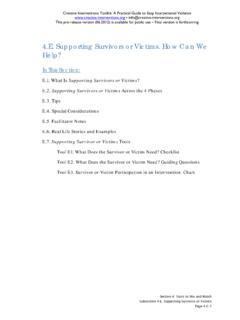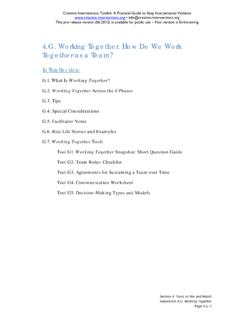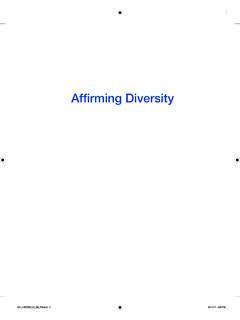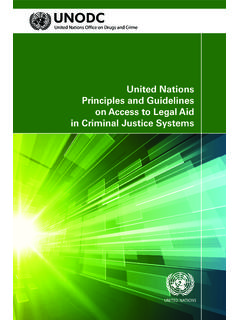Transcription of Welcome to the Creative Interventions Toolkit
1 Welcome to the Creative Interventions Toolkit : A Practical Guide to Stop Interpersonal ViolencEAll content is the same as the Toolkit that has been available on since Toolkit is also available in a shorter Workbook form. See Creative Interventions Workbook:A Short and Practical Guide to Stop Interpersonal Violence. 2012 Creative InterventionsGraphic redesign in 2018 by Danbee Deb KimPermission to reproduce and adapt all content with acknowledgment of Creative Interventions . Take this work, use it and make it your own! Creative of contentsPreface & Creative Interventions : The Story Behind This Toolkit A Community Effort P-7 Section 1.
2 Introduction & Welcome S1-2 The Community-Based Intervention to Violence: An Introduction Who Is This Toolkit For? What Is in This Toolkit ? What Is Our Bigger Vision? Real Life Stories to Share This Toolkit as a Work in Progress FAQ - Frequently Asked Questions about the Toolkit S1-30 Section 2. Some Basics Everyone Should Introduction What Is the Community-Based Intervention to Interpersonal Violence? Interpersonal Violence: Some Basics Everyone Should Know Violence Intervention: Some Important Lessons S2-37 Section 3.
3 Model Overview: Is It Right for You? Introduction Reviewing the Community-Based Intervention to Interpersonal Violence What This Model Is NOT Building a Model on Generations of Wisdom Values to Guide Your Intervention What Are We Trying to Achieve: 3 Key Intervention Areas Interventions over Time: 4 Phases Tools for Interventions : 8 Sets of Tools Model at a Glance: Tools across the 4 Phases Tools to Use Before You Get Started Next Steps S3-35 Section 4.
4 Tools to Mix and Introduction Getting Clear. What Is Going On? Staying Safe. How Do We Stay Safe? Mapping Allies and Barriers. Who Can Help? Goal Setting. What Do We Want? Supporting Survivors or Victims. How Can We Help? Taking Accountability. How Do We Change Violence? Working Together. How Do We Work Together as a Team? Keeping on Track. How Do We Move Forward? S4H-1 Section 5. other resources .H\ 'H QLWLRQV :RUGV :H 8VH DQG :KDW 7KH\ 0 HDQ WR &UHDWLYH ,QWHUYHQWLRQV 6 Real Life Stories and Examples from the Toolkit Creative Interventions Anti-Oppression Policy Community-Based Responses to Interpersonal Violence Workshop Taking Risks.
5 Implementing Grassroots Community Accountability Strategies, by Communities Against Rape and Abuse (CARA) Distinguishing between Violence and Abuse, by Connie Burk, Northwest Network of Bisexual, Trans, Lesbian and Gay Survivors of Abuse Portrait of Praxis: An Anatomy of Accountability, by Esteban Kelly and Jenna Peters-Golden of Philly Stands Up (PSU) Confronting Sexual Assault: Transformative justice on the Ground in Philadelphia, E\ %HQFK $QV HOG DQG 7 LPRWK\ &ROPDQ RI 3 KLOO\ 6 WDQGV 8S 368 6 Shame, Realisation and Restoration: The Ethics of restorative Practice, by Alan Jenkins Tips for Seeking a Therapist [for People Who Have Done Sexual Harm], by Anonymous Resource List S5-116list of toolsSection 3.
6 Model Overview: Is It Right for You? toolsTool Is This Model Right For You? Checklist S3-31 Tool Values to Guide Your Intervention. Creative Interventions Checklist S3-32 Tool Values to Guide Your Intervention (In Your Own Words). Guiding Questions S3-33 Tool Values to Guide Your Intervention (In Your Own Words). Checklist S3-34 Section 4A. Getting Clear ToolsTool A1. Getting Clear Snapshot: Short Question Guide S4A-18 Tool A2. Getting Clear Worksheet S4A-21 Tool A3. Naming the Harm Chart S4A-22 Tool A4.
7 Harm Statement Worksheet S4A-26 Tool A5. Getting Clear: Intervention Factors At-a-Glance S4A-27 Section Staying Safe ToolsTool B1. Risk Assessment Chart S4B-19 Tool B2. Safety Plan and Action Worksheet S4B-23 Tool B3. Safety Plan and Action Chart S4B-29 Tool B4. Escape Safety Checklist S4B-32 Tool B5. Meeting Person Who Did Harm Safety Worksheet S4B-35 Section Mapping Allies and Barriers ToolsTool C1. Mapping Allies & Barriers: Snapshot/Quick Guided Questions S4C-16 Tool C2. Mapping Allies & Barriers: Worksheet S4C-17 Tool C3.
8 Ally Roles Checklist S4C-19 Tool C4. Good Ally Checklist S4C-20 Tool C5. Allies to Work with the Person Doing Harm Chart S4C-22 Tool C6. Barrier Checklist S4C-25 Tool C7. Allies and Barriers: Summary S4C-27 Tool C8. Invitation to Help with an Intervention S4C-29 Section Goal Setting ToolsTool D1. Dealing with Strong Negative Feelings and Fantasy during Goal Setting S4D-20 Tool D2. Goal Setting Guided Questions and Chart S4D-21 Tool D3. Mapping Combined Goals Chart S4D-24 Tool D4. Shared Collective Goals Chart S4D-25 Tool D5.
9 Collective Goals Summary Checklist and Next Steps S4D-26 Tool D6. Turning Goals into Action S4D-31 Section Supporting Survivor or Victims ToolsTool E1. What Does the Survivor or Victim Need? Checklist S4E-20 Tool E2. What Does the Survivor or Victim Need? Guiding Questions S4E-22 Tool E3. Survivor or Victim Participation in an Intervention Chart S4E-24 Section Taking Accountability ToolsTool F1. Staircase of Change S4F-52 Tool F2. Level of Participation for Survivors or Victims Chart S4F-637 RRO ) 6 HOI 5H HFWLRQ DQG *XLGLQJ 4 XHVWLRQV IRU 6 XUYLYRUV RU 9 LFWLPV DQG $OOLHV S4F-677 RRO ) 6 HOI 5H HFWLRQ DQG 3 UDFWLFH IRU $OOLHV 3 UDFWLFH 4 XHVWLRQV S4F-78 Tool F5.
10 Breaking through Defensiveness. Guiding Questions for Person Doing Harm S4F-817 RRO ) 3 UHSDULQJ IRU 'LUHFW &RPPXQLFDWLRQ $I UPDWLRQV DQG *XLGHG 4 XHVWLRQV for the Person Doing Harm S4F-83 Section Working Together ToolsTool G1. Working Together Snapshot: Short Question Guide S4G-19 Tool G2. Team Roles: Checklist S4G-22 Tool G3. Agreements for Sustaining a Team over Time S4G-28 Tool G4. Communication Worksheet S4G-29 Tool G5. Decision-Making Types and Models S4G-33 Section Keeping on Track ToolsTool H1.









